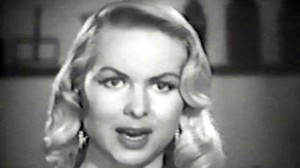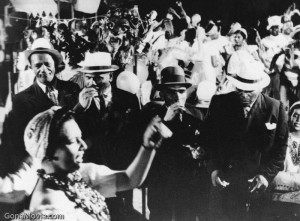This was written on February 25, 2007, provoked by yet another case of a Wellesian pseudo-expert bonding with another non-expert to lay down what is supposed to be the definitive history and wisdom on the subject. Sanford Schwartz did write me a short, polite, private response that, as nearly as I can recall, didn’t really engage with any of my arguments. — J.R.
To the Editors:
I’m grateful for Sanford Schwartz’s article about Orson Welles in the March 15 issue of the New York Review of Books, which strikes me as being far more sensitive to Welles’s work and some of the issues posed by his troublesome career than most pieces I’ve read on the subject by nonspecialists. Even if Schwartz’s ideas about Welles as a proto-surrealist are more provocative than convincing to me, they do lead to some arresting observations about his visual style. So I hope he’ll forgive me for pointing out an error in his piece and a few assertions that I believe are misleading. They all derive from confusions that invariably greet any effort made to describe Welles in relatively simple terms.
First, the error: “Although [Welles] was involved with many films that for one reason or another weren’t brought off, he actually finished only twelve, a group that includes the fairly short F for Fake and The Immortal Story, both made for TV.” But if we’re including films made for TV (which incidentally don’t encompass F for Fake), there are at least four TV pilots Welles finished (one of them, in my opinion, a major work — the 25-minute, 1958 The Fountain of Youth). There’s also the 84-minute essay film Filming Othello (1979), which would bring the number of features to thirteen. But part of the problem with sticking to even this number is that, as James Naremore points out, it’s not always a simple matter determining what a “work” by Welles consists of, much less a single finished feature. Both The Magnificent Ambersons and Mr. Arkadin qualify as finished only in the sense that they were completed by others, whereas Welles completed the editing of two separate versions of his Macbeth and at least two versions of his Othello (and lamentably, along with The Fountain of Youth and Filming Othello, neither of these Othellos is currently available; we only have the second edited version with a substantially and posthumously altered soundtrack). Schwartz describes the posthumously edited Four Men on a Raft as “a surviving section of the Brazilian documentary,” but what survives is the footage of an unfinished film, whereas we know that Welles came far closer to finishing Don Quixote — before proceeding to dismantle it, which happened long before the posthumous “completion” of that film by Jesus Franco. So what films count as finished, and what films don’t? Sticking with the usual consumerist models doesn’t really clarify matters.
And some of the same confusion crops up in assessing Welles scholarship, as opposed to lazy mythic speculation. One sure way of distinguishing Welles scholars from nonspecialists is how they regard David Thomson’s completely unreliable Rosebud, which Schwartz calls “often dazzling and insightful,” though it’s backed by no independent research or personal acquaintance with Welles, isn’t mentioned once in either of Simon Callow’s massive volumes, has been rebutted at length by both Joseph McBride and myself, and, as a highly fanciful portrait of Welles’s character, refuted by countless people who knew him. For me, the one hour I once spent with Welles at a lunch has sufficed to disprove Thomson’s contention, seemingly seconded by Schwartz, that his “warmth was confined to nostalgia” — although I would hope that a closer look at the films would also undermine this impression. Even the unedited footage of Four Men on a Raft challenges such a claim.
Jonathan Rosenbaum
Chicago Reader
Chicago, Illinois








